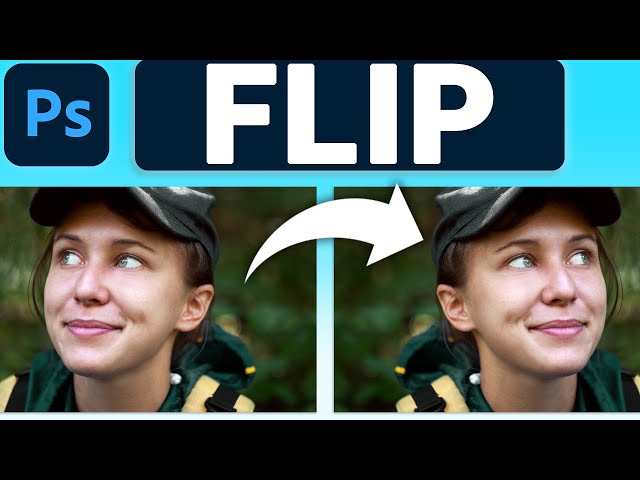Reflecting Perspectives: A Thorough Guide on How to Flip a Photo in Photoshop

Introduction:
In the realm of digital image editing, the ability to flip a photo in Photoshop is a fundamental skill that can transform perspectives, add artistic flair, or correct orientation errors. Whether you’re a novice exploring the basics of photo manipulation or an experienced designer seeking nuanced techniques, this comprehensive guide will walk you through the diverse methods and considerations involved in flipping a photo. From simple horizontal and vertical flips to more advanced reflections, discover the tools and strategies that empower you to reshape your visual narratives.
Chapter 1: The Basics of Flipping in Photoshop
1.1 Horizontal Flip:
- Introduce the concept of a horizontal flip, a straightforward method for mirroring an image along its horizontal axis. Explore step-by-step instructions using the Flip Horizontal command or the Transform tool, highlighting the impact on composition.
1.2 Vertical Flip:
- Explore the vertical flip, another essential technique that mirrors an image along its vertical axis. Discuss how this method can correct orientation issues, create visual interest, or offer a fresh perspective on familiar subjects.
Chapter 2: Utilizing the Transform Tool
2.1 Accessing the Transform Tool:
- Guide users on accessing the Transform tool, a versatile feature for flipping and transforming images in Photoshop. Discuss the importance of maintaining aspect ratios and offer tips for a seamless transformation.
2.2 Rotating and Scaling:
- Explore additional capabilities of the Transform tool, such as rotating and scaling. Discuss how these adjustments complement flipping, allowing for creative transformations and precise control over the final composition.
Chapter 3: Flipping Layers and Smart Objects
3.1 Flipping Individual Layers:
- Discuss the process of flipping individual layers within Photoshop. Explore how this technique can be used to selectively mirror specific elements while leaving others unchanged, offering flexibility in design.
3.2 Advantages of Smart Objects:
- Introduce Smart Objects as a powerful tool for non-destructive editing. Discuss how using Smart Objects in conjunction with flipping techniques preserves image quality and allows for reversible transformations.
Chapter 4: Creating Reflections and Symmetry
4.1 Generating Reflections:
- Guide users in creating reflective effects through flipping. Discuss how flipping an image and blending it with the original can simulate reflections on water surfaces or enhance the visual impact of architectural photography.
4.2 Achieving Symmetry:
- Explore techniques for achieving symmetrical compositions through photo flipping. Discuss the importance of balance, visual harmony, and the impact of symmetry on the overall aesthetic of an image.
Chapter 5: Flipping Text and Graphic Elements
5.1 Flipping Text Layers:
- Discuss considerations and techniques for flipping text layers in Photoshop. Explore how flipping text horizontally or vertically can be used for creative typographic effects or to enhance design compositions.
5.2 Flipping Graphic Elements:
- Guide users in flipping graphic elements within a composition. Discuss the impact of flipping individual elements, such as logos or illustrations, on the overall visual storytelling of an image.
Chapter 6: Advanced Techniques with Perspective and Distortion
6.1 Perspective Flipping:
- Introduce advanced techniques for flipping images with perspective adjustments. Discuss how the Vanishing Point filter and other distortion tools can be applied to create dynamic perspectives and add depth to compositions.
6.2 Distortion for Artistic Expression:
- Explore the artistic potential of distortion in conjunction with flipping. Discuss how intentional distortions can evoke a sense of surrealism, abstraction, or convey specific moods within an image.
Chapter 7: Batch Processing and Automating Flipping Tasks
7.1 Batch Flipping Images:
- Guide users in batch processing and flipping multiple images simultaneously. Discuss the benefits of automating repetitive tasks, saving time, and maintaining consistency across a series of photographs.
7.2 Recording Actions for Efficiency:
- Introduce the concept of recording actions to automate flipping tasks. Discuss how creating custom actions in Photoshop streamlines workflows, enhances productivity, and ensures precision in repetitive editing tasks.
Chapter 8: Flipping for Correction and Restoration
8.1 Correcting Perspective Errors:
- Discuss how flipping can be employed to correct perspective errors in architectural or interior photography. Explore scenarios where flipping horizontally or vertically rectifies skewed angles and enhances visual harmony.
8.2 Restoring Historical Photographs:
- Explore the use of flipping in restoring historical photographs. Discuss techniques for repairing damage, correcting orientation issues, and revitalizing vintage images while preserving their authenticity.
Chapter 9: Exporting and Saving Flipped Images
9.1 Saving Flipped Images:
- Provide guidance on saving flipped images in various formats. Discuss considerations for preserving image quality, choosing appropriate file types, and optimizing images for specific purposes, such as web display or print.
9.2 Maintaining Metadata and Exif Information:
- Discuss the importance of maintaining metadata and Exif information when saving flipped images. Explore how preserving this data ensures accurate details about the photograph, such as camera settings and location.
Chapter 10: Sharing Flipped Creations and Seeking Feedback
10.1 Showcasing Flipped Photos: – Discuss various platforms for showcasing flipped photos. Explore social media, online portfolios, and creative communities where photographers and designers can share their flipped creations and engage with a broader audience.
10.2 Seeking Constructive Feedback: – Highlight the value of seeking constructive feedback on flipped images. Explore online forums, photography communities, and collaborative platforms where users can share their work, learn from others, and refine their flipping techniques.
Conclusion: Redefining Perspectives – Your Mastery in Photo Flipping
In conclusion, the art of flipping photos in Photoshop is a journey of redefining perspectives and unleashing creative possibilities. This comprehensive guide has equipped you with a diverse set of tools, techniques, and strategies to confidently flip images, whether for correction, artistic expression, or storytelling. May your flipped creations resonate with innovation and captivate audiences with fresh visual narratives. Happy flipping!





